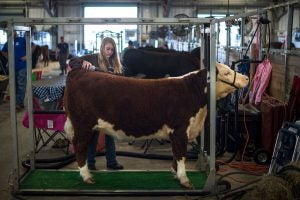The county fair may last only a week, but those who show beef know that grooming, growing, and training is a year-round job — especially if you want to succeed as it comes time to judge a beef cow. You want lots of hair on beef cows, and you want it standing up in just the right way so that it will make the animal look bigger and more uniform. A beef cow’s hair grows better when it is washed daily with cold water, conditioned, and brushed often. This takes a lot of dedication!
The way we judge a beef heifer is a little different from the way we judge a beef steer. Beef heifers are judged on their structural correctness, volume, style and balance, degree of muscling, and femininity in that order. Beef steers are judged very similarly, but since steers are not entering a breeding market, there are a couple of key differences. Beef steers are judged on their degree of muscling, degree of finish (fat cover), growth capacity, structural correctness, balance, and frame size in that order.
But what do these terms all mean? Take a look at how to properly judge a beef cow!
Structural correctness
To analyze structural correctness, you have to take a look at the animal’s feet and legs, hock, rump, and shoulders. The animal should stand with straight legs, and all toes pointing forward. Their rump should be long and level from hooks to pins, and their shoulders should be smooth looking and allow the animal to stand comfortably. If an animal’s legs bow out, if their toes aren’t straight, they don’t walk comfortably, or their legs are sickle, these are all things that take points away from their structural correctness.
Volume
Volume is determined by width, depth, and length of body. The body width concerns the shape of the ribs, the ideal animal has a big round rib cage, allowing the animal to consume more. You judge body depth from the side, and you are visually measuring from the top of the back to the bottom of the belly — you want the belly to be half way between the ground and the top of the back. The length of body is the length between the shoulders and the flank, and you want the animal to be long, but proportional. I like to compare this to a big 50-gallon drum — that is exactly how their body between the shoulders and flank should look.
Style and Balance
Judging style and balance includes the top line, the uniformity of volume, the smoothness and angularity in the front, and the blending of the shoulders, ribs and hips. The topline of the animal is the highest point along their backbone, and this should be straight throughout. A bow in the top line could indicate weakness in the loins or pain from walking. The volume of the animal should be uniform and look natural, your animal really should look like a big barrel!
The smoothness and angularity in the front refers to how the head blends into the neck, and how that blends into the shoulders. An ideal animal will naturally hold their head high, have a long neck free from a lot of excess skin, and the top of their neck will blend into the topline, while the bottom of the neck will cleanly drop into the brisket. Similarly, the shoulders of the animal should be smooth and hardly noticeable, and they should blend smoothly into the ribs, and the ribs should blend into the hips. Often young animals who are still growing won’t have smooth blending from the shoulders to the hips because they aren’t filled out, but this blending often comes with time.
Degree of muscling
To evaluate the degree of muscling you will evaluate the width from flank to flank standing directly behind them. You want the animal to be wide and round, with lots of room between the legs while they walk. You want them to stand with their feet a hip length apart. Additionally you’ll want to take a look at their top line. Does their topline stand out, or does it look like a “V” with muscle standing out on either side? You want the topline of your cow smooth, but to have lots of muscle around it.
Femininity
Evaluating femininity is very similar to evaluating style and balance. A breeding heifer or cow is not going to enter the meat market as soon as steers are, so it is not as important to see big muscles, but more important to see traits that promote longevity and strength. While a steer or bull might have a big bulky neck, it would be favorable to see a leaner neck on a heifer or cow. Where you’d like to see a big round rump on a steer or bull, you’d like the heifer and cow to be a little leaner.
Degree of finish
The degree of finish refers to the fat cover over the shoulders, ribs, topline, tail head, flank, brisket, and cod or udder. You want to see the animal smooth all over, not being able to see any ribs or pin bones. But remember, the animal shouldn’t be so fat that they have no definition!
Growth capacity
To evaluate growth capacity you have to ask yourself if the animal has room to fill out. The ideal animal has great width in their chest, width between feet when standing, has a big depth of body, open ribs, and they are long. If they don’t have room to pack in muscle and fat, then they don’t have much capacity to grow.
Frame size
Frame size has a lot to do with the ideal finishing weight of your animal. The ideal animal looks proportional, whereas an animal with poor frame size might appear too tall without enough fat cover, or too short with too much fat cover.
Judging a beef cow is much easier than raising and training them! If you want to practice judging beef cattle, I suggest checking out the resources by the University of Kentucky.

Elizabeth Maslyn is a Cornell University student pursuing a career in the dairy industry. Her passion for agriculture has driven her desire to learn more, and let the voices of our farmers be heard.



